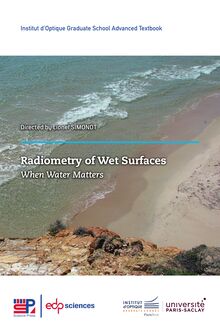Radiometry of wet surfaces , livre ebook
130
pages
English
Ebooks
2023
Obtenez un accès à la bibliothèque pour le consulter en ligne En savoir plus
Découvre YouScribe en t'inscrivant gratuitement
Découvre YouScribe en t'inscrivant gratuitement
130
pages
English
Ebooks
2023
Obtenez un accès à la bibliothèque pour le consulter en ligne En savoir plus
Publié par
Date de parution
02 février 2023
Nombre de lectures
1
EAN13
9782759829316
Langue
English
Poids de l'ouvrage
12 Mo
As everyone can see every day, many objects or materials change their appearance when they get wet. Most of the time, the object becomes more translucent, its color darker and more chromatic. Beyond these general trends, is it possible to predict these changes in appearance for a given type of surface, and for a given humidity level? This is the question studied in this book, by drawing up a first inventory of available knowledge and ongoing research in multiple fields of application: in remote sensing, to correctly identify surfaces and estimate moisture content; in public lighting, to improve visibility on wet roads; in computer graphics, to render wet surfaces in a more realistic way… There is no universal model to describe the changes in spectral, angular and spatial responses of a wetted surface. The mechanisms of light scattering are not affected in the same way according to whether the material is porous, fibrous, powdery, and can be filled by water, or impermeable and can be covered by a water layer. In some applications where the infrared domain is of interest, the strong absorptance of water is also to be considered. This book was initiated by the GDR Appamat, a grouping of research focused on material appearance created in 2019 by the French national center for scientific research (CNRS). In 9 chapters, 26 specialists from various disciplines present different approaches that open perspectives on this field of research. Hopefully, students, engineers, and researchers will be inspired by these ideas to propose future developments.
Preface .....................................................III
CHAPTER 1
Visual Effects of Surface Tension on the Appearance of Wet Surfaces ...... 1
Pascal Barla, Loїc Lachiver and Gaёl Guennebaud
1.1 Different Types of Surfaces................................. 2
1.2 Surface Tension at Various Scales............................ 4
1.3 A Phenomenological Model................................. 5
1.4 Discussion.............................................. 8
References.................................................. 8
CHAPTER 2
Reflectance of Wet Natural Soils in the SolarDomain: Contributions and Limitations of PhysicalModels................................ 11
Alice Dupiau, Stéphane Jacquemoud and XavierBriottet
2.1 Layered Models.......................................... 13
2.2 Particulate Models....................................... 16
2.3 BRF Models............................................ 19
2.4 Conclusion and Perspectives................................ 21
References.................................................. 23
CHAPTER 3
Can the Interpretation of Wet Sand Spectral Responses be Considered a Solved Problem?............................................ 27
Gladimir V. G. Baranoski and Mark Iwanchyshyn
3.1 Case Study: Expected and UnexpectedPredictions ............... 30
3.2 Practical Implications and FuturePerspectives .................. 33
References.................................................. 34
CHAPTER 4
Spectro-Photometric Signatures of Water inPlanetary Regoliths ......... 37
Antoine Pommerol, Marion Massé and Bernard Schmitt
4.1 Experimenting with Analogues.............................. 39
4.2 Reflectance Measurements.................................. 40
4.3 BRDF of Wet JSC Mars-1 and Basalt Samples.................. 40
4.4 Spectral Evolution of Drying Salt-Basalt Mixtures ............... 42
4.5 Reflectance of Intimate Mixtures of WaterIce and Dust ........... 45
4.6 Conclusions and Perspectives............................... 47
References.................................................. 47
CHAPTER 5
Measure of Optical Properties of Paper when wetting using Monte-Carlo Inversion................................................... 51
Laurent Brunel
5.1 Radiative Transfer Properties............................... 52
5.2 Measurement of Radiative Transfer Properties .................. 52
5.3 Experiments ............................................53
5.4 Results................................................ 55
5.5 Interpretation........................................... 58
5.6 Comparison Between Rendering and Photography ............... 58
5.7 Conclusion .............................................60
References.................................................. 60
CHAPTER 6
Wet Road Surfaces, a Challenge for Road Users…and for Measurement ... 63
Enoch Saint-Jacques and Roland Brémond
6.1 The BRDF of Road Surfaces ................................63
6.2 Wet Road Surfaces....................................... 66
6.3 BRDF Measurement of Road Surfaces and Wetness Monitoring ..... 67
6.4 Measurements of the “Wetness” with UGE’s In-Lab
Goniore flectometer .......................................69
6.5 Conclusion............................................. 71
References.................................................. 72
CHAPTER 7
A Virtual Goniophotometer for Modeling the Light Scattered by Rough Surfaces Covered with a Water Layer.............................. 73
Mickaël Ribardière, Benjamin Bringier, ArthurCavalier, Léo Jourdy, Lionel Simonot, Mathieu Hébert and Daniel Meneveaux
7.1 Virtual Goniophotometer.................................. 75
7.2 Results and Discussion.................................... 79
7.3 Conclusion............................................. 83
References.................................................. 84
CHAPTER 8
Determination of the Water Layer Thickness from the Laser Halo ........ 85
Lev Dolin, Fanny Dailliez and Lionel Simonot
8.1 Laser Halo Theory: Formulation of the Problem ................. 86
8.2 Halo Formed by Light Within Non-Scattering Water.............. 89
8.3 Influence of Light Scattering in Water on the Halo Visibility ........ 92
8.4 The Water IOP Determination Algorithms..................... 98
References.................................................. 101
CHAPTER 9
Impact of a Transparent Layer on the Color of a Non-Homogeneous Colored Support.............................................. 103
Fanny Dailliez, Mathieu Hébert, Lionel Simonot, Lionel Chagas, Anne Blayo and Thierry Fournel
9.1 Halo Effect and Darkening Phenomenon....................... 104
9.2 Reflectance Modelling..................................... 106
9.3 Application to Halftone Colors.............................. 113
References.................................................. 115
Contributors ................................................117
Publié par
Date de parution
02 février 2023
Nombre de lectures
1
EAN13
9782759829316
Langue
English
Poids de l'ouvrage
12 Mo
